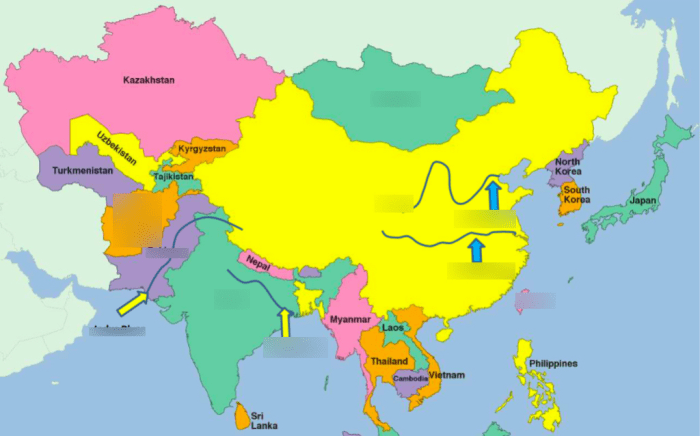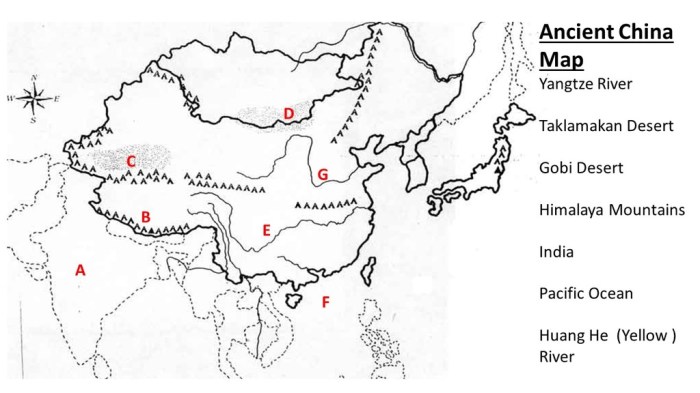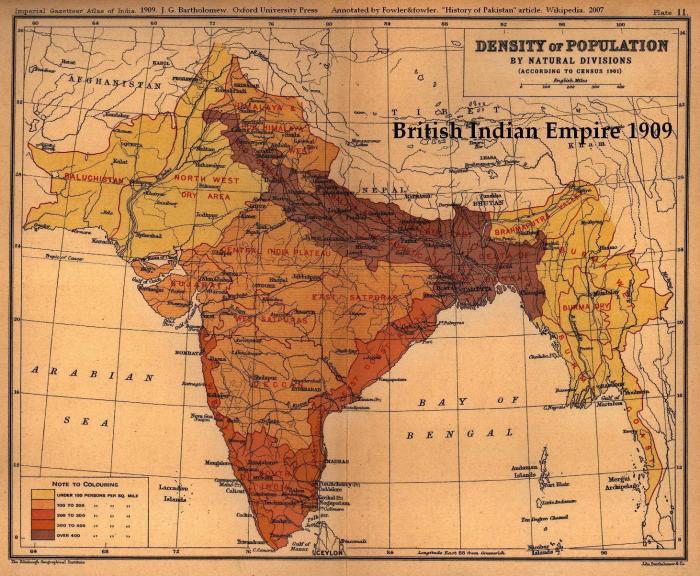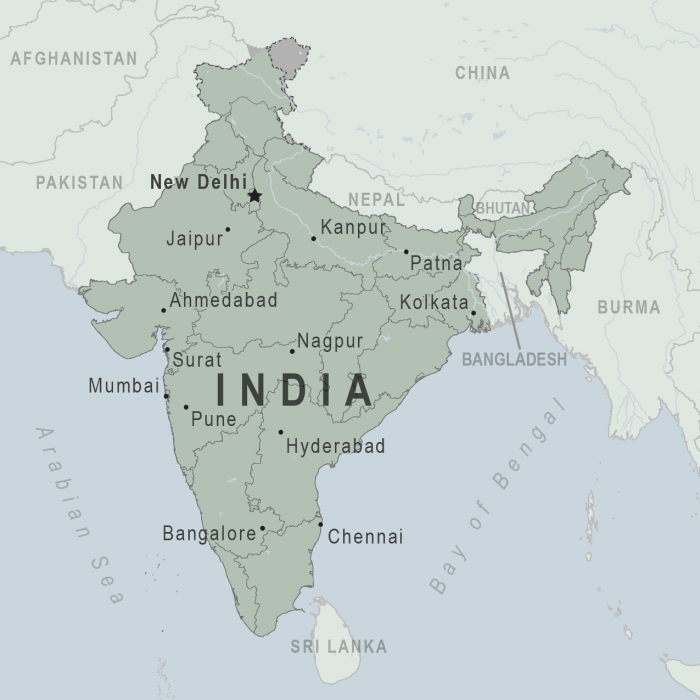Map of ancient india labeled – Embark on a captivating journey through time as we delve into the map of ancient India, labeled to reveal the intricate tapestry of its geographical and historical grandeur. From its sprawling empires to its vibrant cultural centers, this map invites us to explore the rich legacy of a civilization that shaped the course of human history.
Ancient India, a land of unparalleled geographical diversity, was home to mighty rivers, towering mountains, and fertile plains. Its strategic location at the crossroads of major trade routes made it a hub of commerce and cultural exchange. As we traverse this ancient landscape, we will encounter the remnants of glorious empires, witness the rise and fall of dynasties, and discover the profound influence of religion and culture on Indian society.
Historical Context
Ancient India holds a significant place in world history, serving as a cradle of civilization and a hub of cultural exchange. Its geographical location at the crossroads of Asia, with access to both land and sea trade routes, contributed to its prosperity and cultural diversity.
Empires and Kingdoms
Ancient India witnessed the rise and fall of numerous empires and kingdoms, each leaving an indelible mark on its history and culture. The Mauryan Empire, founded by Chandragupta Maurya in the 4th century BCE, was one of the largest and most powerful empires in ancient India.
It stretched from present-day Afghanistan to Bengal and introduced a centralized administration and a unified legal system.
Other notable empires included the Gupta Empire, known for its golden age of art, science, and literature, and the Mughal Empire, which ruled over much of the Indian subcontinent from the 16th to the 19th century.
Geographical Features

Ancient India was a vast and diverse land, with a wide range of physical features. From the towering Himalayas in the north to the fertile plains of the Ganges River in the east, the geography of India has played a significant role in shaping its history and culture.
To delve into the intricacies of ancient India, a labeled map can serve as an invaluable guide. As you explore the vast subcontinent, you may encounter the enigmatic phrase “he aqui os doy potestad” ( he aqui os doy potestad ), a testament to the enduring legacy of a bygone era.
This ancient map, with its carefully marked locations and borders, offers a glimpse into the rich history and cultural tapestry of India.
The most prominent geographical feature of ancient India is the Himalayas. These towering mountains formed a natural barrier between India and the rest of Asia, protecting the subcontinent from invasion and conquest. The Himalayas also provided a source of water for irrigation and agriculture, as well as a home for a variety of plants and animals.
Major Rivers
Ancient India was home to several major rivers, including the Ganges, Indus, and Brahmaputra. These rivers provided a vital source of water for irrigation and transportation, and they also played a significant role in the development of Indian civilization.
| River | Description |
|---|---|
| Ganges | The Ganges River is the longest river in India. It flows from the Himalayas to the Bay of Bengal, and it is considered sacred by Hindus. |
| Indus | The Indus River flows from the Himalayas to the Arabian Sea. It was the site of one of the earliest civilizations in the world, the Indus Valley Civilization. |
| Brahmaputra | The Brahmaputra River flows from the Himalayas to the Bay of Bengal. It is one of the largest rivers in the world, and it is important for irrigation and transportation in northeastern India. |
Other Geographical Landmarks
In addition to its rivers and mountains, ancient India was also home to a variety of other geographical landmarks. These landmarks include the Thar Desert in the west, the Deccan Plateau in the south, and the Eastern Ghats in the east.
- Thar Desert: The Thar Desert is a large desert in western India. It is one of the driest places in the world, and it is home to a variety of desert plants and animals.
- Deccan Plateau: The Deccan Plateau is a large plateau in southern India. It is made up of a series of hills and valleys, and it is home to a variety of forests and grasslands.
- Eastern Ghats: The Eastern Ghats are a range of mountains in eastern India. They run along the coast of the Bay of Bengal, and they are home to a variety of forests and wildlife.
Trade and Commerce

Ancient India was a vibrant hub of trade and commerce, with a network of trade routes connecting it to various regions of the world. These routes facilitated the exchange of goods, ideas, and technologies, contributing to the prosperity and cultural development of the subcontinent.
Major Trade Routes
- Grand Trunk Road:A major land route connecting North India to the Gangetic Plain and Bengal, facilitating trade between the northern and eastern regions.
- Silk Road:A network of trade routes connecting China to Central Asia, Persia, and Europe. India served as a vital link in this network, providing goods such as spices, textiles, and ivory.
- Sea Routes:India had a well-developed maritime trade network, with ports along its western and eastern coasts. Major ports included Bharuch, Sopara, and Tamralipti.
Trading Centers and Ports
- Taxila:A major trading center in North India, located on the Grand Trunk Road.
- Pataliputra:The capital of the Mauryan Empire, located on the banks of the Ganges River, was a hub for trade and commerce.
- Ujjain:A trading center in Central India, known for its textile industry.
- Bharuch:A major port on the west coast, known for its trade in cotton, silk, and spices.
- Tamralipti:A port on the east coast, known for its trade in rice, ivory, and pearls.
Goods and Commodities
Ancient India exported a wide range of goods, including:
- Spices:Pepper, ginger, turmeric, and other spices were highly sought after in Europe and other regions.
- Textiles:India was renowned for its fine cotton and silk textiles, which were exported to various parts of the world.
- Ivory:India had a thriving ivory trade, with elephants being found in abundance in the subcontinent.
- Precious Stones:India was a source of diamonds, rubies, and other precious stones.
In return, India imported goods such as:
- Horses:Horses were imported from Central Asia and Persia.
- Gold and Silver:These precious metals were imported from various regions, including the Roman Empire.
- Wine:Wine was imported from Greece and other regions.
- Glassware:Glassware was imported from the Roman Empire and other Mediterranean regions.
The trade and commerce of ancient India played a significant role in the development of the subcontinent, fostering economic growth, cultural exchange, and the spread of ideas.
Cultural and Religious Centers

Ancient India was a melting pot of cultures and religions, each leaving its unique mark on the landscape. From the sacred banks of the Ganges to the bustling cities of the north, cultural and religious centers flourished, shaping the beliefs and practices of the Indian people.
Major Cultural and Religious Centers
* Varanasi (Kashi): A holy city on the banks of the Ganges, Varanasi is one of the oldest continuously inhabited cities in the world. It is considered the holiest city in Hinduism and is a major pilgrimage destination for Hindus.
Ayodhya
The birthplace of Lord Rama, Ayodhya is a sacred city for Hindus. It is a popular pilgrimage site and is home to several ancient temples.
Mathura
Another holy city on the banks of the Yamuna River, Mathura is the birthplace of Lord Krishna. It is a major pilgrimage site for Hindus and is home to several important temples.
Harappa
One of the oldest cities in the world, Harappa was a major center of the Indus Valley Civilization. It is known for its advanced urban planning and architecture.
Mohenjo-daro
Another major city of the Indus Valley Civilization, Mohenjo-daro is located in present-day Pakistan. It is known for its well-preserved ruins and advanced drainage system.
Religious and Cultural Practices, Map of ancient india labeled
The cultural and religious centers of ancient India were hubs of religious and cultural activity. People from all over the subcontinent would travel to these centers to bathe in sacred rivers, visit temples, and participate in religious festivals. These centers were also centers of learning, where scholars and priests studied and taught religious texts.The
following table compares and contrasts the different cultural and religious influences in ancient India:| Cultural/Religious Center | Religious Significance | Cultural Significance ||—|—|—|| Varanasi (Kashi) | Holy city on the Ganges | Center of Hindu pilgrimage || Ayodhya | Birthplace of Lord Rama | Major pilgrimage site for Hindus || Mathura | Birthplace of Lord Krishna | Major pilgrimage site for Hindus || Harappa | Major center of the Indus Valley Civilization | Advanced urban planning and architecture || Mohenjo-daro | Major center of the Indus Valley Civilization | Well-preserved ruins and advanced drainage system |
Political Divisions

Ancient India was a land of diverse political entities, ranging from small kingdoms to vast empires. These political divisions played a crucial role in shaping the history and culture of the region.
The political landscape of ancient India was characterized by a complex interplay of monarchies, republics, and empires. Monarchies, ruled by kings or queens, were the most common form of government. Republics, governed by elected assemblies, were also present in some areas.
Empires, ruled by powerful emperors, emerged from time to time, bringing large territories under their control.
Major Political Entities
- Magadha Empire:Founded by Bimbisara in the 6th century BCE, the Magadha Empire grew to become one of the largest and most powerful empires in ancient India. It was ruled by the Mauryan dynasty, including the famous emperor Ashoka.
- Nanda Empire:Preceded the Mauryan Empire, the Nanda Empire was a powerful kingdom in ancient India. It was known for its wealth and military strength.
- Gupta Empire:The Gupta Empire, founded by Chandragupta I in the 4th century CE, was another major empire in ancient India. It was a period of great cultural and economic prosperity known as the “Golden Age of India.”
- Vijayanagara Empire:The Vijayanagara Empire was a Hindu kingdom in southern India that flourished in the 14th and 15th centuries CE. It was known for its military prowess and architectural achievements.
- Mughal Empire:The Mughal Empire, founded by Babur in the 16th century CE, was a Muslim empire that ruled over much of the Indian subcontinent. It was known for its cultural synthesis and architectural marvels, such as the Taj Mahal.
Artistic and Architectural Heritage: Map Of Ancient India Labeled

Ancient India was a hub of artistic and architectural excellence, with a rich legacy that continues to inspire today. From grand temples to intricate sculptures, the artistic traditions of ancient India showcased the skill and creativity of its artisans.
Architectural Styles
Ancient Indian architecture evolved over centuries, with distinct styles emerging in different regions. Key architectural styles include:
- Harappan Architecture:Characterized by well-planned cities, baked brick structures, and sophisticated drainage systems.
- Buddhist Architecture:Known for its stupas, viharas (monasteries), and chaityas (prayer halls), featuring intricate carvings and sculptures.
- Hindu Temple Architecture:Evolved over time, with towering shikharas (spires) and elaborate mandapas (halls), often adorned with intricate sculptures and paintings.
li> Islamic Architecture:Influenced by Persian and Central Asian styles, featuring domes, minarets, and arches.
Important Monuments
Ancient India is home to numerous architectural marvels, including:
- Taj Mahal:An iconic white marble mausoleum built by Emperor Shah Jahan in memory of his wife.
- Ajanta and Ellora Caves:A series of Buddhist and Hindu cave temples adorned with stunning frescoes and sculptures.
- Khajuraho Temples:A group of Hindu temples renowned for their erotic sculptures.
- Brihadeeswarar Temple:A massive Hindu temple in Tamil Nadu, known for its towering gopuram (gateway tower).
Sculptures and Paintings
Ancient Indian sculptures and paintings showcased a wide range of themes, including religious, mythological, and everyday life. Notable examples include:
- Sanchi Stupa Reliefs:Depicting scenes from the life of Buddha.
- Apsara Dancers at Khajuraho:Graceful and sensual female figures carved on the temple walls.
- Miniature Paintings:Exquisitely detailed paintings illustrating religious texts and historical events.
Q&A
What were the major empires that existed in ancient India?
The Maurya Empire, the Gupta Empire, and the Mughal Empire were among the most significant empires in ancient India.
What were the major trade routes that passed through ancient India?
The Silk Road, the Grand Trunk Road, and the Sea Trade Routes were important trade routes that connected India with other parts of the world.
What were the major cultural and religious centers in ancient India?
Taxila, Nalanda, and Varanasi were prominent cultural and religious centers in ancient India.